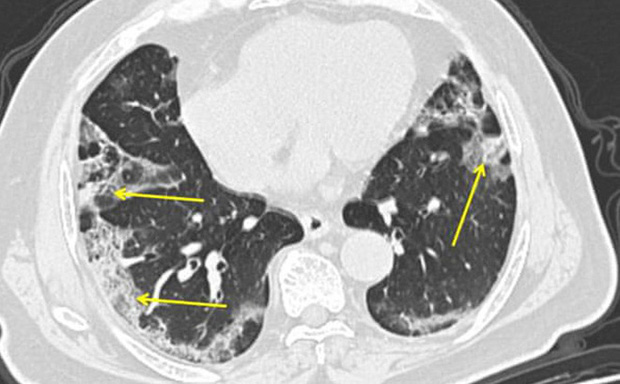Unlike common pneumonia: What happens to the lungs of COVID-19-infected patients?
- Tram Ho
The Guardian cited WHO as saying that about 80% of COVID-19-infected patients recover without special treatment. However, 1 out of 6 people will be in critical condition and have trouble breathing.

The photo shows a CT scan of a patient infected with COVID-19. Pneumonia caused by corona virus causes the lungs to have noticeable blurring on the outer edge of the lungs. Photo: Mount Sinai Hospital / AP
How does the virus affect the human body?
Professor John Wilson, the newly elected principal of the Royal Australian College of Medicine and an expert on respiratory diseases, said nearly all of the serious symptoms of COVID-19 are similar to pneumonia.
According to Mr. Wilson, people infected with COVID-19 can be classified into four groups.
The first group is the “subclinical” people and those infected with the virus but have no symptoms.
The second group of people is infected in the upper respiratory tract. That means that this patient will have a fever, cough and have mild symptoms such as headache and conjunctivitis.
“People with mild symptoms can still infect the virus but will not realize it,” Wilson said .
The third group, which accounts for the majority of COVID-19-positive cases, is those who have flu-like symptoms and conditions that prevent them from working.
The fourth group, according to Mr. Wilson, will have severe symptoms like pneumonia.
“In Wuhan, among those who are positive for COVID-19 and need medical assistance, about 6 percent are in critical condition,” he said.
WHO says older adults, people with underlying medical conditions such as high blood pressure, heart disease, lung disease or diabetes are more likely to suffer from severe symptoms than others.
How does pneumonia develop?
When people with COVID-19 cough and fever, Wilson said this is the result of an infection in the airway between the lungs and the outside.
“The lining of the airways is damaged, causing inflammation and allergies,” Wilson said. “Even a small layer of dust can cause a patient to cough.”
“If the disease worsens, the virus will invade the end of the airways, causing inflammation to the air sacs in our lungs.”
According to Wilson, when the air sacs in the lungs are filled with inflammatory substances, the lungs will not be able to provide enough oxygen to the blood, reduce the body’s ability to receive oxygen and reduce the capacity to eliminate CO2.
“This is often the cause of death in patients with severe pneumonia,” he said.
Professor Christine Jenkins, president of the Australian Lung Foundation and leading respiratory specialist, said: “Unfortunately, we haven’t had any method to prevent pneumonia when we have COVID-19 infection Doctors have tried all kinds of medicines and we hope to find a way to combine the medicine that works. Currently, there are no effective treatments other than active treatment. We support patients to breathe and maintain oxygen levels high enough until their lungs can function normally once they recover. “
Wilson says patients with viral pneumonia are likely to have other complications, so doctors may need to use other drugs to treat them.
“In some cases, it is still not enough to cure the disease. Pneumonia is overgrown and the patient does not recover,” he said.
Is COVID-19 pneumonia different?
Professor Jenkins said the COVID-19-induced pneumonia differs from most other cases.
“Nearly every case of pneumonia we know is caused by bacteria and therefore antibiotics can be used.”
Wilson said there was evidence that pneumonia caused by COVID-19 could become very serious. According to Wilson, cases of this type of pneumonia often affect the entire lung, rather than a small fraction.
“Once the virus enters the lungs and air sacs, the body responds by killing the virus and limiting the virus to multiply,” he said.
However, this reaction mechanism may not be activated in some groups of patients, including those with heart and lung disease, diabetes and the elderly.
Professor Jenkins said, in general, people over 65 years of age are at high risk for pneumonia. Patients who are infected with diseases such as diabetes, cancer, and chronic diseases affecting the lungs, heart, kidneys, liver, smokers, children under 12 years old are also subject to attention.
“Age is a significant factor affecting the risk of dying from pneumonia. Pneumonia is always a serious disease for the elderly and in fact one of the main causes of death for them. This is because the human immune system weakens over the years, making it harder for the body to cope with diseases and infections. “
Source : Genk

